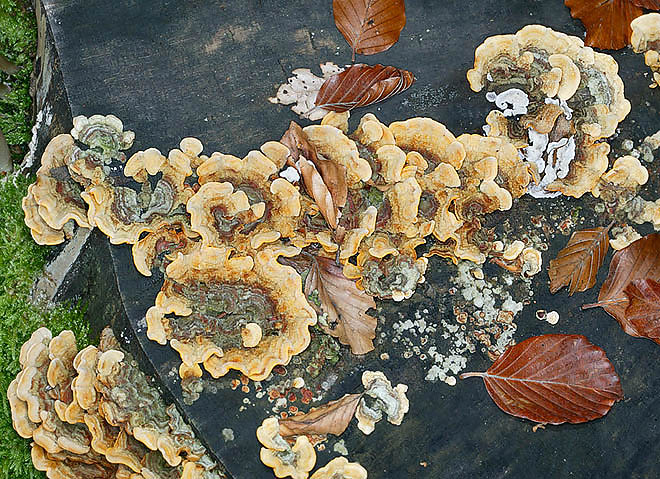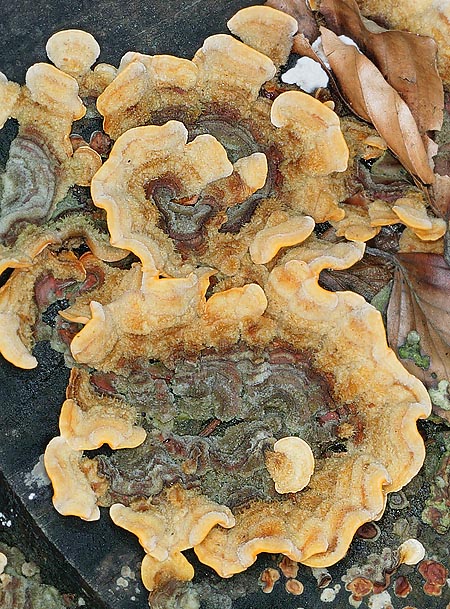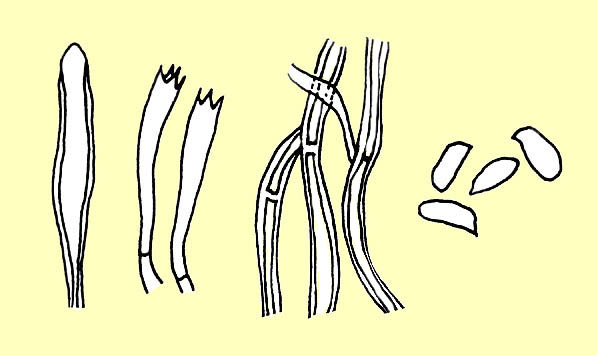
Text © Massimiliano Berretta

English translation by Mario Beltramini

Stereum hirsutum fructifies all the year on broadleaf trees stumps or logs © Giuseppe Mazza
Family: Stereaceae Pilát, 1930.
Genus: Stereum Persoon ex S.F.Gray, 1821.
Stereum hirsutum (Willdenow Ex Fries) S.F.Gray, 1821.
The name of the genus comes from the Greek “stereós” = firm, sturdy, rigid; whilst hirsutum comes from the Latin “hirsutus” = rugged, due its villous surface.
It is a fungus which does not hold any alimentary interest, therefore it has no current or dialectal names in Italy.
In France it is known under the name of “Stérée hirsute”; in Germany, “Zottiger Schichtpilz”, “Striegeliger Schichtpilz”; in UK as “Hairy parchment”.
Description of the genus
In the Genus Stereum are standing resupinate as well as effused-reflexed carpophores, only in a few instances, shortly stipitate, with wavy, lobed margin; smooth hymenophore, at times a little warty, placed in the lower part of the fungus; the flesh is coriaceous-elastic or woody. Dimitic hyphal system with structural hyphae, hyaline generative hyphae without clamp connections.
White spore print, amyloid spores, cylindraceous, smooth, without germinative pore. Saprotrophic species vegetating on the spoiled wood of various broad-leaved trees or conifers.

Particular of the fancy inedible hymenium © Giuseppe Mazza
Description of the species
Cap: usually expanded-reflexed, rarely resupinate, often with overlapped caps, imbricate and bracket-shaped; villous pileus surface more evident towards the connection point to the substratum, irregularly sinuous and waved; the colour, variable, goes from the orange-yellow to the brown or grey-yellow, with concentric zones of brown-orange and often paler margin.
Hymenium: placed in the lower part of the cap, resting on the substratum, smooth, sometimes somewhat gibbous, from yellowish to orangey, in the older specimens it becomes ochre-grey or hazel.
Stipe: absent.
Flesh: very scanty, thin, brownish yellow, with coriaceous consistency but elastic.
Habitat: it fructifies all the year round on rotten wood of broad-leaved trees, on logs, stumps or big branches.
Edibility: does not have any alimentary value due to the little flesh and mainly because coriaceous.
Microscopy: hyaline spores, cylindraceous, smooth, 5.5-7.5 x 2-3,5 µm. Generative hyphae 2-4 µm broad, without clamps, 3-6 µm broad structural hyphae.
Remarks. It is the most common fungus, recognizable by the velvety basidiomes and the yellow-orangey colouration.
Over the years, between the 1800 and the 2009, they have created even 26 entities among forms and varieties of the typus species. There are several other species of Stereum not always easy to determine macroscopically.
Much similar are: Stereum subtomentosum Pouzar, which, however, is slightly stipitate, has a short haired surface, thinner than S. hirsutum, whilst the habitat is the same; Stereum insignitum Quèlet , growing in a southernmost area, stipitate too, having darker pileus colours and pale ochre hymenium, with cylindraceous of clavate elements decorated with excrescences at the apex (pseudo-acanthopodious).

Stereum hirsutum terminals of skeletal hyphae, basidia, generative hyphae and spores © Pierluigi Angeli
Then, there are three species turning to the red when touched, which are: Stereum sanguinolentum (Albertini & Schweinitz ex Fries) Fries, growing only on conifers: (Pinus, Picea and Larix); Stereum rugosum (Persoon ex Fries) Fries, which, however, grows on broad-leaved, especially Fagus and whose spores are bigger; Stereum gausapatum (Fries) Fries, also growing on broad-leaved but on wood of Quercus, with slightly longer spores.
Stereum ochraceoflavum (Schweinitz) Saccardo, is a small species with paler colours on the whitish-grey on the sterile part, the hymenium pale grey or grey-yellowish, growing on small branches of broad-leaved, especially Quercus.
Stereum reflexulum D. A. Reid which is a resupinate southern Europe species, growing on broad-leaved trees and on bushes, with cap having a grey surface, small (0,5 cm), often with pink hues on the hymenium.
Synonyms: Thelephora hirsuta Willdenow 1787 (basionym); Auricularia aurantiaca Schumacher 1803; Auricularia reflexa Bulliard 1786; Auricularia reflexa var. reflexa Bulliard 1786 ; Boletus auriformis Bolton, 1788; Helvella acaulis Persoon 1800; Helvella acaulis Hudson 1778; Stereum reflexum (Bulliard) Saccardo 1916; Thelephora reflexa (Bulliard) Lamarck & DC. 1805.
→ For general notions about Fungi please click here.
→ To appreciate the biodiversity of MUSHROOMS please click here.
